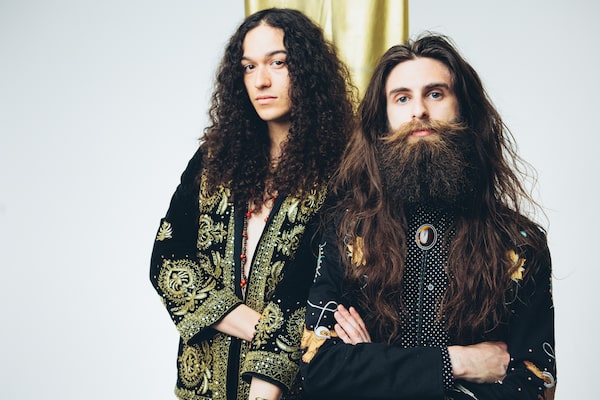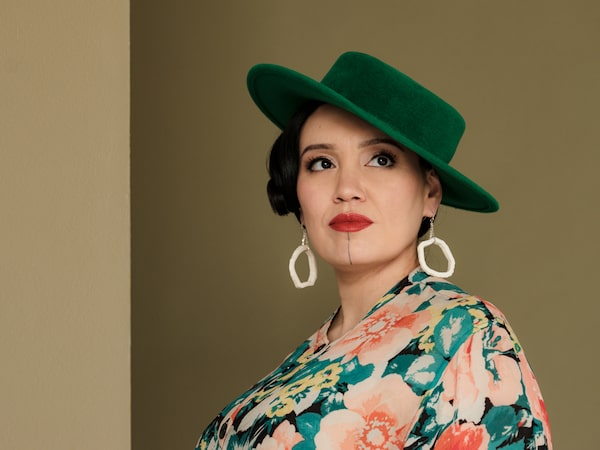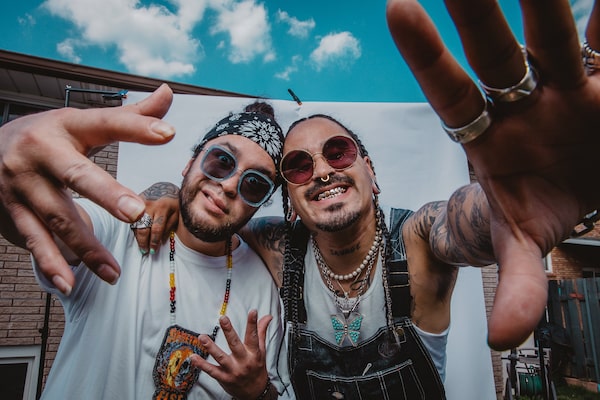
Since forming in 2014, Crown Lands has released five EPs and a full-length album, landed a deal with Universal Canada and won a Juno.andy ford/Handout
When the Haisla hip-hop duo Snotty Nose Rez Kids performed at this year’s Juno Awards, they wore custom wood-carved masks and fringed ceremonial aprons while dancers in traditional regalia stepped to the rhythm of a beating drum. Photos of totem poles from their home territory of Kitamaat Village in B.C. flashed on stage as they rapped, “This revolution will be live, and decolonized, for the next seven generations, all my relations.”
Snotty Nose Rez Kids are part of a larger movement of Indigenous artists celebrating their cultures and shining a light on issues facing their communities that had long been ignored in the mainstream. Dubbed the “Indigenous renaissance” by Wolastoqiyik composer Jeremy Dutcher, these artists incorporate traditions, such as throat singing and oral storytelling, into music that ranges from politically charged rap to indie folk.
The artists featured here are breaking boundaries, bringing fresh voices, ideas and techniques to our sonic landscape.
Crown Lands
From: Oshawa, Ont.
Style: Nostalgic rock ‘n’ roll
When listening to Crown Lands you immediately hear echoes of their musical heroes – Rush, Led Zeppelin, Queen. But unlike the typical rock ‘n’ roll set, the band’s songs explore themes such as Indigenous sovereignty, land defenders, and missing and murdered Indigenous women, girls and two-spirits.
Even the band’s name is a political statement. Vocalist and drummer Cody Bowles, who is of Mi’kmaw heritage and two-spirit, says it’s a reference to reclaiming stolen land. “I feel like I’m honouring my path as a human being to talk about these things,” said Bowles, who plays alongside Kevin Comeau, guitarist, bassist and keyboardist in the two-piece group. “Highlighting Indigenous voices and struggles is a core value of Crown Lands and will always be,” Bowles says.
Since forming in 2014, the band has released five EPs and a full-length album, landed a deal with Universal Canada and won a Juno. Next year it’s releasing two more albums, including an instrumental concept album about the Mi’kmaw legend of the great horned serpent.
Under the guise of classic rock, Crown Lands’ message reaches people who may not usually think about the historical violence of the RCMP or the Land Back movement.
“There’s people who come to our shows who don’t even know what Crown land is,” says Comeau, who is Jewish. “It’s a big responsibility and we have to do it right.”
Crown Lands is on tour with Greta Van Fleet in the U.S. and plays across Canada in the spring of 2023 with July Talk.

Throat singing is the backbone to many of Beatrice Deer’s songs.Alexi Hobbs/Handout
Beatrice Deer
From: Montreal
Style: Throat-singing “Inuindie” rock
Beatrice Deer is an Inuk and Mohawk musician who sings in English, French and Inuktitut, her mother tongue and the language she’s most comfortable expressing herself in. But when words aren’t enough, Deer also incorporates throat singing – a rhythmic call-and-response style traditionally performed by Inuit women, which was banned in Canada in the 18th century – into her songs.
“I didn’t grow up with throat singers around me because throat singing was almost erased by colonialization,” says Deer, who learned the art form as a teenager at workshops in her hometown of Quaqtaq, a fishing village in the Nunavik region of Northern Quebec.
Throat singing is the backbone to many of Deer’s songs. On her most recent album, Shifting, she effortlessly blends traditional Inuit folklore and performance styles with contemporary indie rock and pop, a deft mixing of genres that Deer calls “Inunidie.”
She is currently working on a children’s album in Inuktitut, featuring a mix of original and traditional Inuit songs. Modernizing traditional songs is something Deer also did with Shifting, when she reworked the traditional song AANNGIQ with a stirring vocal loop layered with haunting throat singing.
For Deer, creating new variations of old Inuit songs is a way to honour her ancestors and contribute to a long history of reinterpreting folk songs across regions.
“Traditional songs are valuable to our history, our culture, our identity and we need to keep playing and singing them so the younger generations can know and sing them too,” she says.

SNRK, or Snotty Nose Rez Kids, have millions of listeners on Spotify.Kaylee Smoke
Snotty Nose Rez Kids
From: Vancouver
Style: Politically charged hip-hop
If you ask Snotty Nose Rez Kids their origin story, they’ll tell you they started from the bottom: open mic nights. In 2016, straight out of college, cousins Quinton “Yung Trybez” Nyce and Darren “Young D” Metz spent their weeknights performing in small Vancouver clubs, steadily growing their fan base.
“That’s where we sharpened our tools,” says Metz. “We learned how to control the crowd, how to get their attention, how to win people over. For us, the best way to gain fans is through live music.”
Now, six years later, the duo, whose name nods to their adolescence growing up in a Haisla Nation in northwest British Columbia, has millions of listeners on Spotify. They’ve toured around the world, performed at the 2022 Juno Awards, and had three albums shortlisted for the prestigious Polaris Prize, including their fourth album, Life After, released last year.
Blending hard-hitting rap with energetic R&B, Life After tackles topics from anti-Indigenous racism and violence to celebrations of unabashed joy and confidence in their heritage. The stirring and powerful Red Sky at Night was influenced by Colten Boushie, a 22-year-old Cree man killed in Saskatchewan by a white farmer, whose acquittal sparked protests across the country. Next month, the duo will release their fifth album, I’M GOOD, HBU.
Their music resonates with their Indigenous fans, many of whom have told Nyce and Metz their songs have given them strength and helped them reconnect with their culture.
“People would say, ‘My son started growing his hair after he heard Long Hair Don’t Care” or say, ‘Your music has gotten me through the worst times that I’ve gone through,’” says Metz. “First and foremost, we write music that we want to hear, and to see there’s so many other people out there that feel the same is phenomenal.”
Snotty Nose Rez Kids play Toronto at Velvet Underground on Dec. 10
Cassidy Mann credits her Ojibwa heritage with instilling a love for oral storytelling, and how it can capture memories and experiences.Kiandra Jeffery/Handout
Cassidy Mann
From: Winnipeg
Style: Wistful, acoustic pop songs
Cassidy Mann’s debut EP, If It’s Not Forever, weaves small details into vivid narratives that, while autobiographical, feel universal. She credits her Ojibwa heritage with instilling a love for oral storytelling, and how it can capture memories and experiences. “My family and sense of community have influenced my songwriting,” says Mann, whose father is from Sagkeeng First Nation. “I learned about my culture from older cousins and aunties at Sun Dance ceremonies and powwows, not from school.”
Mann feels buoyed by the current wave of Indigenous musicians, many of whom she’s met at workshops and shows. Being surrounded by other young artists feels hopeful, says Mann, although she also understands the complexities of representation. “As a young, Indigenous artist, you want to be recognized as that, but you also want your music to speak for itself. You just want to be an artist,” she says.
Musical duo OMBIIGIZI, comprised of Anishinaabe musicians Daniel Monkman and Adam Sturgeon, met in 2019 while performing as their solo projects.Rima Sater/Handout
OMBIIGIZI
From: Toronto and London, Ont.
Style: Indie rock honouring family histories
Anishinaabe musicians Daniel Monkman and Adam Sturgeon were recording OMBIIGIZI’s debut album Sewn Back Together when unmarked graves were found at the grounds of a former residential school near Kamloops, B.C. The news hung heavy over the studio, but for Monkman and Sturgeon, it was also deeply personal. Both have survivors in their families, and grew up knowing of the atrocities inflicted at Canada’s residential schools.
On Sewn Back Together, released on Arts & Crafts and shortlisted for this year’s Polaris Prize, Monkman and Sturgeon unpack family memories and cultural histories over expansive indie rock. The kinetic Residential Military was inspired by Sturgeon’s grandfather, who was taken from his family as a young boy and put into residential military schools. On the wistful and shimmering Cherry Coke, Monkman evokes memories from his teen years with his father on Brokenhead Ojibway Nation, located near Winnipeg. “I wanted this album to be about reclaiming our Indigeneity and learning about where we came from; that knowledge that was lost and stolen,” Monkman says.
Bringing these intimate songs to the public sphere was nerve-wracking. As Indigenous artists, the two sometimes feel they’re carrying the weight of their communities through their music. “But we also feel that there’s a great responsibility to do it because art has such a way to reach people. It is such a healthy tool for us as individuals,” Sturgeon says.
The duo met in 2019 while performing as their solo projects Zoon and Status/Non-Status, respectively. At the time, they “felt a little isolated in the indie sphere as Indigenous musicians who were trying to represent and uplift our community,” Sturgeon says. “We became a support for one another.”
For Monkman and Sturgeon, the more Indigenous artists there are reclaiming their identities and telling their stories, the more empowered the music scene becomes.
“There’s a lot of Indigenous voices coming up to the surface, and I don’t feel so alone,” says Monkman. “That’s been the world to me.”
 Samantha Edwards
Samantha Edwards